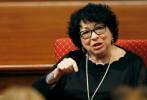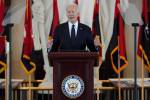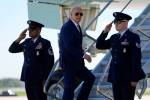Vietnam ‘Lucky Ones’ remember stories of survival 50 years later
Fifty years after Vietnam’s bloodiest battles, the ‘lucky ones’ recall their time there
Kathryn Barents got home from work that fall night in 1967 to find somber family members gathered in the living room, and her shaken father, Henry, waiting to speak with her.
She feared this was about her husband, Paul, a Marine Corps lieutenant in Vietnam. They had been married only a few months, and his class had just completed the Basic Officer Course in Quantico, Virginia, in August.
Ten from the class had already been killed, and she figured that Paul, 23, had now been added to the list.
Her father brought her into the kitchen, and they sat down. Paul had been grievously wounded in a friendly-fire incident. His legs had been shattered, and would later be amputated.
But she was lucky. He was alive.
This week, Paul Barents, now 72, and Kathryn Barents, 71, of Easton, Maryland, will join scores of Marine Corps veterans and their spouses outside Washington for a 50-year reunion of Paul’s graduating class from the Marines’ Basic School for officers.
There were 516 of them in class 5-67, most college graduates, like Paul, in their early 20s who trained as infantry platoon leaders and were sent almost directly to the war, which was reaching its height.
Dozens of Americans were being killed every day, and the toll was especially great for officers.
The men of 5-67 were the sons and grandsons of immigrants, and the sons of Marines who had fought in World War II.
There was a college wrestling star, and a baseball player with a shot at the major leagues.
Most of them were single. But a few were married, and some had children. One, 2nd Lt. Morrell Crary, was killed in action five days after his daughter was born back home in Salem, Ore.
Some lasted only a few days in Vietnam — two were killed Oct. 14, 1967, the day after they arrived, according to a classmate who knew them.
Others made it a few months before they were killed or wounded.
One man was spared death when a buddy persuaded him to skip a flight on a transport plane that was shot down, killing everyone on board.
Thirty-nine from the class perished, in battles around well-known places like Khe Sanh, and Con Thien, and at forgotten locales like Thon Tham Ke, “Bastards Bridge” and “Antenna Valley.”
Twelve would receive posthumous medals for courage — four got Navy Crosses, three Silver Stars, four Bronze Stars and one a Distinguished Flying Cross.
One classmate would be missing in action for 36 years, until his body was located in 2004. The remains of two others have never been found.
But many, like Barents, have moved beyond the lifelong physical scars from the war to enjoy successful and productive lives.
They are in their 70s now, with white hair and grandchildren. A few still have mementos of the war — faded telegrams sent to their families, a memorial card from a friend’s funeral, snapshots of themselves in Vietnam.
This year and next year, when most of the men served, mark the 50th anniversaries of some of the bloodiest months of the Vietnam War. The year 1967 saw the deaths of 11,400 Americans, and 1968 claimed 16,900, the worst yearly toll of the war, according to the National Archives.
The two years account for almost half the 58,000 names on the Vietnam Veterans Memorial in Washington, which honors those killed by the war.
Since the war, the men of class 5-67 haven’t met often. This is only their fifth get-together. They went separate ways after the conflict and reunited for the first time in 2008.
Now 50 years have passed. Many survivors from the class have died. Some are too sick to attend the reunion. And while their four days together will be a time of comradeship and remembrance, one of them said, “we might not do this again.”
- - -
Second Lt. Paul Barents was setting up a night ambush south of the Vietnamese town Phu Bai when he got a radio call from his captain to be alert for an attack from across a river behind him.
He passed the warning to his front-line Marines, and in a crouch began making his way through the underbrush to warn men he had posted in the rear.
It was Dec. 7, 1967. Barents had been in Vietnam about 10 weeks and had yet to see much action.
He and Kathryn, then 22, had been a married only a short time.
They were both from Massachusetts, she via northern New Jersey. They had met while they were college students, working in the kitchen of a dining hall at the University of Massachusetts at Amherst.
They had hit it off, and were married June 17 at Our Lady of Sorrows Church in South Orange, New Jersey. He wore his dress white uniform. She was in a white wedding gown.
He had joined the Marine Corps right out of college. He believed it was an outfit with purpose, and he went to Vietnam “thinking we were doing a noble thing,” he said. “I really did.” Doubt emerged mainly in hindsight, he said.
He had been hesitant about marriage because he knew he would be going to the war.
But Kathryn told him: “I’d rather be your wife for three months than not all.”
“Starting in 1965, ‘66, we became more aware of the losses over there,” she said. “So by the time the class of ‘67 went, we knew the fatalities were going to be pretty high.”
“I was prepared for that,” she said.
(Both of Paul’s roommates at the basic school and a fellow who lived across the hall were killed in action.)
The couple had lived in Woodbridge, Va., while he was at Quantico, and three months after their wedding they were saying goodbye at an airport in New York.
She drove their 1963 Pontiac back to her parents’ home in Andover, Mass., to await his return.
In Vietnam, he wrote Kathryn regularly and discussed, among other things, whether she should get her hair cut before they met in Hawaii when he had R&R.
“I wouldn’t mind if you cut your hair for Hawaii,” he wrote her nine days before he was wounded. “The only thing that has to be there is you.”
In another letter, he told her he had cut back on his smoking, and closed with, “Well, beautiful, I guess I better go.”
Now, as he crept back to his men in the darkness, a new Marine in the platoon mistook him for an enemy soldier and opened fire with an M-16 rifle. Barents had always trained his men to aim low at night, so as not to miss high, and the bullets ripped into his legs.
The slugs broke his right thigh bone, both bones in his lower left leg and lacerated critical arteries in both legs.
Barents collapsed, and hollered “Cease fire!” He asked his men to take off his boots, and someone gave him some shots of morphine.
Medevac was called. He was placed on a poncho and hoisted into the helicopter. Before it left, one of his men said, “You were a damn good skipper, sir, a damn good skipper.”
Barents was flown to Phu Bai, where he told a superior not to blame the man who shot him. “It was my fault,” he said. “I should have had some kind of better communications.”
On Dec. 18, his right leg was amputated above the knee, and on Dec. 29, his left leg was amputated below the knee. The left leg failed to heal and was later amputated above the knee.
Barents’s part of the war was over.
He regretted being unable to complete his tour and his service. Plus, he thought: “How the hell am I going to make a living?”
And he wondered how Kathryn would react. “I’m not the guy [she] married,” he said.
Back home, the commandant of the Marines had sent her a telegram reporting that Paul’s condition was “serious with his prognosis fair.”
“OK,” she said she thought. “We knew this going in… . Just bring him home. We’ll be fine.”
But her young husband of a few months now had amputated legs.
“It was a game-changer,” she said in a recent interview in their Maryland home. “It changed all our hopes and futures and plans and everything that we dreamed of.”
She wondered whether she would still be attracted to him. He was crippled. There would be no more dancing, no more walks on the beach, she said.
Some people said to her: Wouldn’t it be better if he had just been killed?
“No,” she replied. “I’m one of the lucky ones. He’s coming home.”
Paul was eventually moved to the Philadelphia Naval Hospital, where he would stay for 14 months. They were reunited there in early January 1968.
He was in bed when she walked in. She remembers that he weighed about 75 pounds.
He remembers that she looked terrific.
- - -
At dusk on Jan. 28, 1968, Jack Callanan, call sign “Gold Lemon 1,” was studying a map and reporting over the radio that he and his men had just seized part of the enemy hamlet of Lam Xuan.
He had collected documents from dead enemy soldiers and crammed them into his pockets for intelligence purposes.
Suddenly his radioman yelled, “Grenade!”
Callanan never saw the North Vietnamese soldier who had popped out of a spider hole, and never saw the crude grenade he threw.
But he heard the “kerplunk” when it hit the ground between him and the radioman.
It exploded with a bang, flipped him on his back and drove hot shrapnel into his abdomen, pelvis and left side.
Callanan, 23, was a second lieutenant from the Throgs Neck section of the Bronx in New York City, and one of the five children of parents who had been born in Ireland.
He was a math whiz, with an electrical engineering degree from Manhattan College. After leaving the Marines’ Basic School he had gone to the Army’s Fort Sill, Okla., for 12 weeks of artillery training.
Technically he was a forward observer, a spotter who would call in artillery fire when it was needed. But the fighting in Vietnam often came in such close quarters that it was too dangerous to ask for an artillery attack, lest Americans be hit.
He was stationed with other Marines aboard the USS Valley Forge, an amphibious assault ship just off northern South Vietnam, and had been involved in previous operations, most notably in late December 1967, near a village called Thon Tham Khe.
It was part of Operation Badger Tooth, and aimed to find a large contingent of enemy soldiers reported to be in the area.
The Marines had stumbled on a superbly camouflaged North Vietnamese bunker fortress.
“We took it real bad,” Callanan said in a recent interview in his home in Boston.
Forty-eight Marines were killed. They included his Quantico classmate, 2nd Lt. George Broz, who had been in Vietnam a month.
Now, a month later, during the fight for Lam Xuan just south of the demilitarized zone dividing South and North Vietnam, he was leading a squad of Marines after another lieutenant had been killed by mortar fire.
“It was another one of these fortified villages,” he recalled. “We had to cross some rice paddies, and they had these dikes. We were kind of pinned down on this dike … not quite 50 meters from the periphery of the hamlet.”
“Anybody that stuck their head up over that dike got a bullet between the eyes,” he said.
He maneuvered his men, took some foxholes in the village, and then seized the enemy command and control bunker.
He was reporting in when the radioman yelled.
Callanan didn’t think he was that badly injured, although he was bleeding internally and a wing of his pelvis had been blown off.
“I was very much at ease,” he remembered.
He was wearing a religious medal his mother had given him. “Strangely enough, you’re at peace,” he said. “A calm comes over you. You basically say, you know, ‘Here it is.’ “
Medevac was called in under fire, and Callanan was placed on the helicopter beside the body of the officer he had replaced, 1st Lt. Kenneth Smith.
Smith, whom Callanan knew only as “Smitty,” was one of eight Marines reportedly killed there that day.
Callanan underwent surgery - the first of many over the years - to have shrapnel removed and internal damage repaired, and shipped back to St. Albans Naval Hospital in New York City, where he would be for almost six months.
When a Marine officer came to his parents’ house on Milton Place with the news of his wounds, his mother, Delia, fainted.
Later, she would keep pieces of shrapnel removed from her son’s body in a teacup in a china cabinet at home.
A few weeks after he was wounded, while he was still in the Naval Hospital, he got word that his buddy and Quantico classmate, 2nd Lt. Ferdinando DiStefano Jr., 25, had been killed in a mortar attack near Khe Sanh.
DiStefano was the only child of Italian immigrants. He spoke several languages and wanted to go to language school. But he wound up in the infantry.
The two men would travel together on visits home from Quantico, and Callanan had gone to DiStefano’s to meet his parents.
DiStefano’s mother, Antonietta, spoke little English. His father ran a grocery store on Central Avenue in Brooklyn’s Bushwick neighborhood, according to a news account.
When Callanan was informed of DiStefano’s death, he agreed to be an honorary pallbearer at the funeral. He got a hospital pass and attended the viewing.
He introduced himself to DiStefano’s parents, and his mother remembered him. He recalled her grief. “It was something that was searing,” he said.
The funeral Mass was packed, he recalled. Callanan and other Marines walked behind the casket in dress blue uniforms.
He also attended the burial. “It was a gray, cold, damp day,” he said. “We had a bugler… . When the casket was lowered into the ground, his mother [was] screaming.”
Fifty years later, he still has the laminated memorial card from the funeral. It bears a picture of DiStefano in his Marine Corps uniform.
“O Gentlest heart of Jesus,” the prayer on the card says. “Send thy angels to conduct thy departed servant to a place of refreshment, light and peace. Amen.”
- - -
Second Lt. George Chaconas had to get back to the Khe Sanh Combat Base.
His week-long break from the grinding siege there was over. His R&R in Bangkok, away from the mud and the trenches and the pounding of enemy artillery, had been wonderful.
But now it was time to return.
He had made it as far as Da Nang, and had signed up for a flight that would make the dicey hop from Da Nang to Phu Bai to Khe Sanh, in what was then northwestern South Vietnam.
The C-123 cargo plane was scheduled to leave March 6, according to historian Gregg Jones.
It would eventually carry, along with its crew, 43 Marines. Also onboard would be a young freelance photographer working for Newsweek magazine, Robert Ellison.
Ellison, 23, had been at Khe Sanh 10 days earlier and had taken a stunning series of photographs that Newsweek would run March 18 in a spread called “The Agony of Khe Sanh.”
One picture showed Marines dragging from the bush the body of 2nd Lt. Donald Jacques, 20, one of Chaconas’s 5-67 classmates, who had just been killed.
Now Ellison was heading back to the base.
Chaconas, 23, the grandson of Greek immigrants, had grown up in Northwest Washington and graduated from the University of Maryland.
He had been at Khe Sanh before the siege began in January and would be peppered there by shrapnel from a North Vietnamese artillery or mortar round. Aside from brief leave, he would be present for the entire 77-day siege.
It was a subterranean experience lived in trenches and dugouts often filled with muddy water and populated with huge rats, he recalled in recent interviews in his Washington, District of Columbia, home and via email.
The canned rations were tasteless, and the possibility of death always present. Thousands of artillery shells and mortar rounds fell on the combat base from enemy positions in the surrounding highlands.
Inside the base, where about 6,000 Marines were besieged by 20,000 to 40,000 enemy soldiers, a fellow officer gave Chaconas a copy of Bernard Fall’s book, “Hell in a Very Small Place.”
The historical account, which he still has, tells of the siege and fall of the French bastion of Dien Bien Phu to Vietnamese communists in 1954. “You gotta read this,” Chaconas remembered his friend saying.
Chaconas did, underlining parts in pink marker. ” ‘Whoa, this is exactly what’s going on right now here at Khe Sanh,’ ” he thought at the time.
Nearly 50 years later, he said, “I’m sitting there in my hole, reading this thing … thinking, ‘Holy cow!’ “
Could Khe Sanh be another Dien Bien Phu?
No matter, Chaconas had to get back.
In Da Nang he had met up with his Washington boyhood friend Dick Wooster. Chaconas and Wooster had gone to elementary and middle school together. Both had joined the Marines, and both were, for the moment, in Da Nang.
They hung out, drank beer, and Wooster urged Chaconas to stay the night and skip his flight to Khe Sanh. He could catch one later.
Chaconas agreed.
The next day, when he signed up for the trip to Khe Sanh, a flight coordinator did a double take: “Lieutenant Chaconas? Weren’t you on the airplane yesterday?”
The C-123 had been shot down. Everyone onboard was killed. Officials were notifying families of those whose names had been on the doomed flight’s passenger list.
“My name was on that list,” Chaconas said. “They were filling out the paperwork to tell my parents that I had been killed in Vietnam.”
- - -
The reunion of class 5-67 begins May 3 and runs through May 6.
Jack Callanan, who uses a walker and wheelchair because of complications from his wounds, plans to fly in from Boston. Paul and Kathryn Barents plan to pick him up at the airport and give him a lift to the headquarters hotel in Arlington, Va.
George Chaconas, who is scheduled to lead a reunion tour of Washington, is putting up a couple of the visitors at his home.
Others are expected from Nevada, Vermont, New York, North Carolina, California, Texas and elsewhere.
They won’t gather to tell war stories, said Tony Latorre, 76, who as a young Marine captain helped train class 5-67 a half-century ago and is also attending.
They assemble because “they all shared probably, with the exception of a marriage or the birth of a kid, the most unique experience … [of] their entire lives,” he said.
“They just revel in being … [in] standing there,” he said, in knowing “that you survived it.”
- - -
Magda Jean-Louis contributed to this report.
- - -
Video: Fighting at Khe Sanh, the Vietnam war’s most famous siege
These are excerpts from a 1968 documentary film from Department of Defense outlining the timeline in the Battle of Khe Sanh. (Department of Defense)
Embed code: <iframe width=”480” height=”290” scrolling=”no” src=”//www.washingtonpost.com/video/c/embed/f27434f8-2b8e-11e7-9081-f5405f56d3e4” frameborder=”0” webkitallowfullscreen mozallowfullscreen allowfullscreen></iframe>































